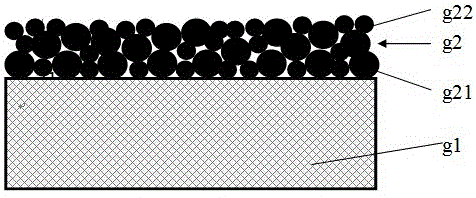Inorganic/organic composite membrane, its preparation method and lithium ion secondary battery containing the membrane
An inorganic composite and separator technology, applied in secondary batteries, battery pack parts, circuits, etc., can solve the problems of small compactness, small surface roughness, insufficient bulk density of separators, poor heat resistance of separators, etc., to improve safety and stability. , The effect of preventing fire accidents and reducing the resistance of transmission
- Summary
- Abstract
- Description
- Claims
- Application Information
AI Technical Summary
Problems solved by technology
Method used
Image
Examples
Embodiment 1
[0050] The preparation methods of the positive electrode sheet, the negative electrode sheet and the lithium-ion secondary battery are all the same as in Comparative Example 1.
[0051] Such as figure 1 As shown, the porous substrate g1 of the organic / inorganic composite membrane is coated with a porous insulating layer g2, and the inorganic particles in the porous insulating layer g2 include the first type of inorganic particles g21 and the second type of inorganic particles g22 with two different particle sizes , the binder is mixed with the inorganic particles and adheres to the surface of the inorganic particles, which is not shown in the figure.
[0052] Preparation of diaphragm:
[0053] (1) Preparation of porous insulating layer g2
[0054] First add 15wt% polyacrylate emulsion (40% in aqueous solution) into deionized water and stir for 1 hour, then add 40% of the first Al 2 o 3 Particles (average particle size 0.3μm, particle size distribution 0.05~2.0μm) and 45wt%...
Embodiment 2
[0058] The preparation methods of the positive electrode sheet, the negative electrode sheet and the lithium-ion secondary battery are all the same as in Comparative Example 1.
[0059] Preparation of diaphragm:
[0060] (1) Preparation of porous insulating layer g2
[0061] First add 15wt% polyacrylate emulsion (40% in aqueous solution) into deionized water and stir for 1 hour, then add 25% of the first Al 2 o 3 Inorganic particles (the average particle size is 0.3μm, the particle size distribution range is 0.08~2μm), 30% of the second Al 2 o 3 Inorganic particles (average particle size 0.6μm, particle size distribution range 0.1~3.0μm) and 30wt% third Al 2 o 3 The particles (with an average particle size of 1.0 μm and a particle size distribution range of 0.1-4.5 μm) were stirred for 2 hours, and then ground in a ball mill for 1 hour to prepare a slurry with a solid content of 40%.
[0062] (2) Coating a porous insulating layer g2 on the surface of the porous substrate...
Embodiment 3
[0065] (1) Preparation of porous insulating layer g2
[0066] Add 3wt% polyvinylidene fluoride to N-methylpyrrolidone and stir at 45°C for 1 h, then add 40% of the first TiO 2 Particles (with an average particle size of 0.25 μm and a particle size distribution range of 0.08 to 1.8 μm), 30% of the second TiO 2 Particles (average particle size 0.7μm, particle size distribution range 0.1~3.5μm) and 27wt% TiO 3 2 The particles (with an average particle size of 1.2 μm and a particle size distribution range of 0.1-5 μm) were stirred for 2 hours and then ground in a ball mill for 1 hour to prepare a slurry with a solid content of 65%.
[0067] (2) Coating a porous insulating layer g2 on the surface of the porous substrate g1
[0068] Take a polypropylene microporous film with a thickness of 12 μm as the porous substrate g1, and then use gravure coating to uniformly cover the prepared slurry on one surface of the porous substrate g1 with a coating thickness of 2 μm, and then strip t...
PUM
| Property | Measurement | Unit |
|---|---|---|
| particle size | aaaaa | aaaaa |
| thickness | aaaaa | aaaaa |
| melting point | aaaaa | aaaaa |
Abstract
Description
Claims
Application Information
 Login to View More
Login to View More - R&D
- Intellectual Property
- Life Sciences
- Materials
- Tech Scout
- Unparalleled Data Quality
- Higher Quality Content
- 60% Fewer Hallucinations
Browse by: Latest US Patents, China's latest patents, Technical Efficacy Thesaurus, Application Domain, Technology Topic, Popular Technical Reports.
© 2025 PatSnap. All rights reserved.Legal|Privacy policy|Modern Slavery Act Transparency Statement|Sitemap|About US| Contact US: help@patsnap.com



